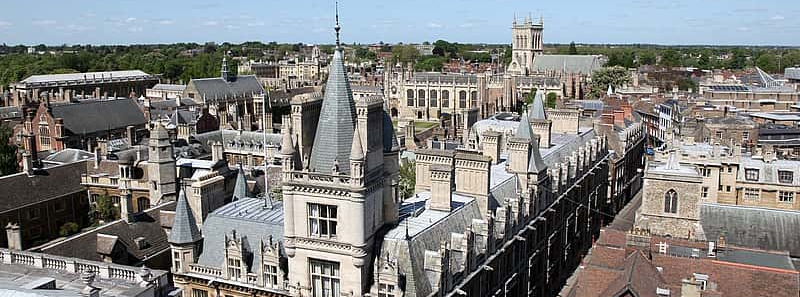IvyWise Scholars Spotlight: Mariel
It’s so important to have perspective when going through the college admissions process, which is why we’ve reached out to one of our own students, Mariel, to share some advice for future applicants.

Cost a very important factor to consider for most students applying to college, especially for those interested in schools in both the U.S. and the U.K. In order to adequately budget for a college degree, applicants need to not only account for tuition costs, but also related expenses such as application fees, tuition, the cost of living in certain cities, and more. U.S. colleges can be pricey, however, it’s not a guarantee that attending university in U.K. will be less expensive in the long run.
So how do U.S. prices compare to fees in the U.K., a popular destination choice for U.S. students who wish to study internationally? Similarly to the U.S., international students studying in the U.K. will not have access to the same funding options and tuition prices as domestic applicants, which makes proper cost considerations even more essential. Keep reading for a side-by-side comparison of college related costs in the U.S. and the U.K. to ensure you find the best-fit universities for you.
When it comes to application prices, the U.K. system is a far less costly option. Students apply through the UCAS, the universal college application in the U.K., and pay £13 (~$17) to apply to one school and £24 (~$32), to send an application to multiple schools. In the U.S., colleges charge individual application fees, which vary depending on the school. According to data collected by U.S. News and World Report, in 2017 the average application cost per school was $43. However, students applying to colleges in the U.S. can request application fee waivers if they qualify financially, and some smaller colleges might waive applications fees for certain applicants.
Depending on the institution, tuition can vary dramatically between the U.S. and the U.K. In the U.K., the government sets a maximum tuition cost for domestic students, which universities cannot exceed. In 2017, the cap increased from £9,000 (~$11,946) to £9,250 (~$12,288). However, according to data from the World University Rankings published in the Times Higher Education, international students studying abroad in the U.K. can expect to pay £12,000 (~$15,938) in tuition, well above the capped rate.
In the U.S., there is no tuition cap, and instead, prices are tiered. In-state tuition at a public university is least costly (at an average of $9,970 annually according to the College Board), followed by out-of-state tuition at a public university ($25,620), with private institutions deemed the most expensive ($34,740), before scholarships and aid are considered.
While sticker prices at U.S. universities can be much higher than U.K. institutions, it’s important to remember that students don’t necessarily pay that price. Many colleges take into consideration students’ ability to pay, and can offer institutional scholarships to international applicants, dramatically decreasing the family’s expected contribution. College Navigator is a great tool to research the average cost of U.S. universities, and all U.S. universities have a college cost calculator on their website to help both U.S. and international families better estimate what they might have to pay.
Cost of living is one of the most important factors to consider when creating a monthly spending budget. The prices for everyday items such as food, toiletries, and transportation vary greatly depending where you reside, so don’t expect prices on a college campus to mirror those of your hometown. Generally, living in a large city can be more expensive, whether it’s in America or the U.K. According to the 2018 Worldwide Cost of Living Survey published in The Economist, New York and Los Angeles are the 13th and 14th most expensive cities in the world, respectively. In contrast, the U.K.’s most expensive city to live in is London, which is ranked 30th. While those rankings can make it look like the U.S. is much more expensive, it’s important to remember that there are over 4,000 colleges and universities in the U.S., with many in smaller cities and communities with a significantly lower cost of living. When evaluating the cost of living, including rent, utilities, groceries, and more, a cost of living calculator can help put these figures into a better perspective. While major U.S. cities might be more expensive than comparable U.K. cities, smaller U.S. cities can be similar or even lower in cost of living.
ROI is one of the biggest considerations for college-bound families, and U.S. universities can offer some of the great ROI when it comes to securing jobs after college. At U.S. universities students have the opportunity to pursue advanced courses, network with professors and alumni, and gain hands-on experience through internships and part-time work. Post graduation, the average starting salaries differ significantly in the U.S. versus the U.K. According to Bridgewater Resources, the average annual wage for recent graduates in the U.K. is 21,000 (~$27,520) while the average for American college graduates is $50,390, based on research from Korn Ferry. Students can also research starting salaries and ROI for specific schools using PayScale.
When it comes to applying to college, cost is just one of many factors to consider. Students should strive to build a balanced list of schools that are good fits socially, academically, and financially. The U.S. and the U.K. have some of the best universities in the world, so it’s important to do thorough research to make sure you’re applying to the schools that are the best fit for you!
Want to learn more about the U.S. admissions process? Check out our video library for tips on essays, applications, and advice for international students applying to U.S. universities!

Finalizing your list of best-fit schools is one of the most important steps of the college application process. Between writing supplemental essays, finalizing personal statements, and requesting letters of recommendation, there’s a lot that students need to prioritize – and often, they put off the difficult task of narrowing down their long list of best-fit schools. Keep reading to learn more about what you should keep top of mind so that you can narrow down your college list and stay ahead of the game on all of your applications.

Founded in 1873, Vanderbilt University is a private research institution known globally for its strong academic programs and research opportunities. This close-knit campus community is located in the heart of Nashville, Tennessee, and offers a college experience unlike anything else. While not an Ivy League school, Vanderbilt is known as a “Southern Ivy” because of its highly selective admissions process and stellar academic reputation.

It can be difficult to choose where to go to college, and it sometimes happens that a student realizes their current school isn’t working for them. Or perhaps a student starts out at a community college before continuing on to a four-year school to finish their degree. Whatever the reason, transferring to another school is always an option. If you’re considering a transfer to another school, you are not alone.